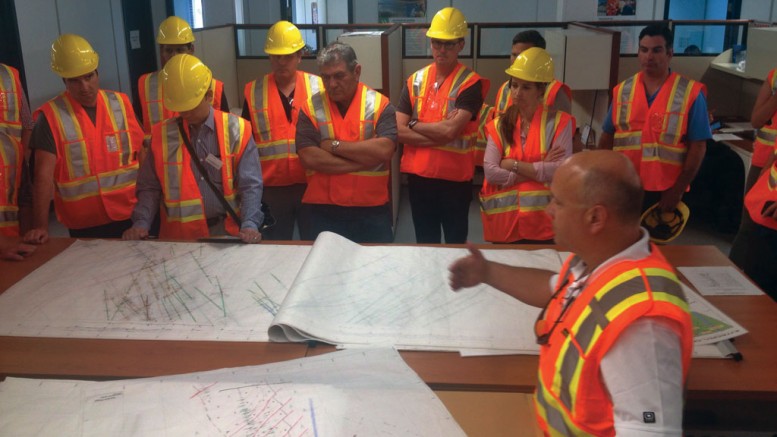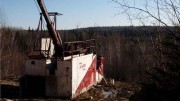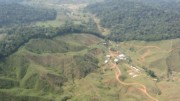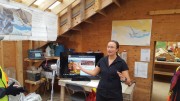VAL-D’OR, QUE. — Just eight months after wrapping up its Gold Rush Challenge exploration competition, Integra Gold (TSXV: ICG; US-OTC: ICGQF) hosted a visit to its Lamaque South gold property, just east of Val-d’Or, Que., to offer analysts and investors, plus The Northern Miner, a sneak peak at some of the newly generated drill targets.
The company has begun a 2,000-metre long “parent” hole to test whether mineralization at the historic, neighbouring Sigma and Lamaque gold mines coalesce at depth. Once complete, the company will drill 15 “daughter” holes off the parent, totalling 8,000 metres, at various intervals to test the target.
Integra president and CEO Stephen de Jong told visitors at a presentation in town that the Lamaque Deep target is the “most interesting” prospect to date, representing the potential down-dip extension of the Lamaque mine, one of the highest ounces of gold per vertical metre deposits in Canada.
“If we hit it, it’ll take a lot more drilling to prove it up, but it could be a real game-changer for the project,” De Jong said. “The structures that host mineralization at Sigma appear to trend towards Lamaque at depth, and if they intercept it would create a perfect environment for gold.”

Cross section of underground workings at the historic Sigma and Lamaque gold mines, including conceptual Lamaque Deep target. Most of the mineralization at Lamaque is hosted within brittle “C-flat” veins that crosscut an intrusive plug, whereas at Sigma, historic workings outline steeply-dipping, mineralized “C” structures that crosscut an easterly-trending dyke swarm. Credit: Integra Gold.
The Lamaque mine, which opened in 1933, produced 4.5 million oz. gold to 1.2 km deep, before shutting down in 1985. The Sigma mine, 500 metres north, produced the same amount over its 60-year mine life, with development extending to 1.9 km depth.
De Jong said the previous operator, McWatters Mining, had partly tested the zone. Despite encouraging results of 45 metres of 2.16 grams gold per tonne, and 40 metres of 2.51 grams gold, McWatters stopped exploring, and shut mining operations in 2003 due to a major reserve grade miscalculation and a subsequent bankruptcty as head grades disappointed amid a prolonged downturn in gold prices.
Hervé Thiboutot, senior vice-president of exploration, continued the conversation in the core shed and exploration office. Inside, geologists had laid out hand-drawn, geological cross-sections displaying the latest drill results.

Mill superintendent Jean-Guy St-Jean (far left) shows investors and analysts Integra Gold’s Sigma mill complex . Photo by Lesley Stokes.
Outside were core boxes cradling high-grade gold intercepts from the property’s key Triangle deposit. The core is riddled with countless high-strain, mylonitic shear zones, which once served as pathways for gold-rich fluids rising as a plume from depth.
The fluids were originally stripped out of partly melted rocks that formed at deep crustal levels as a result of widespread deformation 2.7 billion years ago.
At Triangle, mineralization occurred when a series of steeply dipping mylonites, or “C” structures, wedged their way through a cylindrical-shaped intrusive plug. In response to the strain, the plug shattered into a series of “C-flat” structures and flat, brittle tension gashes, which were later sealed with quartz and gold.
But unlike the other deposits on the property, the mineralized C structures at Triangle extend farther into the surrounding volcaniclastic pile than previously recognized. Thiboutot reckons that’s because the surrounding rocks were altered with silica, and more prone to breaking open when deformed.

A gold-rich mylonite intercepted in drilling at Integra Gold’s Triangle deposit. Credit: Lesley Stokes.

A mylonite from Integra Gold’s Triangle deposit intercepted in drill core. Credit: Lesley Stokes.
“The C4 structure is richer and more continuous than the others we’ve seen at Triangle, perhaps because it had more lateral displacement along it,” he said, noting the the latest drill results have returned 33.6 grams gold over 3.2 metres, and 21.6 grams gold over 5.9 metres. “There was so much movement that it created more open pace, and more fluid moved through it, at least that’s the theory.”
At last count in 2015, the resource stood at 2.6 million indicated tonnes of 7.4 grams gold, and 3.9 million inferred tonnes of 6.9 grams gold, assuming a 3-gram-gold cut-off.
Some of the mineralization, is “impossible to model,” Thiboutot commented.
“The really flat structures mined at Sigma tend to be high grade, but discontinuous. In the context of Sigma, 10% to 15% of the gold produced came from those flat structures, and that’s why Sigma always overproduced relative to its mining model. Those zones can never be calculated with confidence, but they’re present and high grade,” he said.
(The root of McWatters’ problems stemmed from grossly overestimating the amount of gold held in these flat structures.)

Cross section of the Triangle and No. 4 Plug gold deposits with latest drill results. Credit: Integra Gold.
Back at the exploration office, De Jong said the company expects to complete an updated preliminary economic assessment (PEA) for the project by November, which he predicts will be “vastly different” than the one published in early 2015.
“In the last PEA, 70% of the ounces at Triangle were from the C-flat veins — it was done before we discovered the steep C structures,” he said. “So in the new PEA we’re looking at 85 to 90% long-hole mining … and that’s going to make a huge difference in terms of the economics and speed of mining.”

Location map showing the different deposits and targets at Integra Gold’s Lamaque South property. Figure is modified to highlight deposits mentioned in this article. Credit: Integra Gold.

Generalized geology map of Integra Gold’s Lamaque South gold property. Figure is modified to include deposit’s’ mentioned in this article. Credit: Integra Gold.
The previous study, which pooled resources from the property’s Triangle, Fortune, Parallel and No. 4 Plug deposits, envisaged a 1,300-tonne-per-day operation over a 4.5-year mine life.
The underground mine would produce 110,000 oz. gold a year, processed at the company’s 2,400-tonne-per-day Sigma mill complex, which could be scaled up to 5,000 tonnes per day by adding a semiautogenous mill.
The project has an after-tax net present value of $184 million at a 5% discount rate, would generate a 59% internal rate of return.

The historic Sigma pit at Integra Gold’s Lamaque South gold property in Val-d’Or, Quebec. Photo by Lesley Stokes.
“Triangle would be a 1,500- to 2,000-tonne-per-day deposit, and likely won’t go beyond that, so our strategy now is to advance Triangle, and look at satellite deposits that can increase the throughput at the mill to 5,000 tonnes per day,” De Jong said. “Hopefully in a year from now we can show something that could develop into a 180,000 to 250,000 oz. gold per year operation. We need a lot of exploration success to get there, but that’s what we look to do.”
The upcoming PEA will focus on resources at Triangle and No. 4 Plug, which is located 500 metres north of Triangle.
The last resource estimate for the No. 4 Plug was completed in 2013, and tabled 1.3 million indicated tonnes of 5.6 grams gold for 237,000 oz. gold, assuming a 3-gram-gold cut-off.
The company plans to calculate a resource estimate for both deposits early next year, which would include 10,000 metres of additional drilling at the No. 4 Plug and 40,000 metres more at Triangle.
Recent drill intercepts at the No. 4 Plug carried 12.6 grams gold over 21.4 metres, 7.4 grams gold over 14.4 metres and 7.2 grams gold over 14.3 metres.

“Our strategy is to advance Triangle, and look at satellite deposits that can increase the throughput at the mill.”
Stephen De Jong
President and CEO, Integra Gold
Thiboutot explained that the No. 4 Plug is different than Triangle, with most of the mineralization hosted in a cluster of flat-lying, brittle veins within the intrusive, which is more similar to what’s seen at Lamaque. The dimensions of the intrusive, which measures 200 by 150 metres at surface to at least 1 km depth, are also the same as the historic gold mine.
Integra is almost two-thirds of the way through a 120,000-metre drill program at the property, with some of the metres designated to test interpretations of the Donald and Sigma extension prospects.
The company says that Donald could represent the easterly extension of Triangle, whereas the Sigma Extension stands out as a geophysical anomaly, largely untested because it fell along a property boundary before Integra consolidated the land package.
The Sigma Extension was preliminarily tested by Integra in 2011, with results including 23 grams gold over 1.4 metres from 232 metres depth, and 4 grams gold over 2.5 metres from 70.5 metres depth.
The company has also started a 3,000-metre long underground exploration drive into Triangle’s C1 and C2 structures to define a resource and collect a 20,000-tonne bulk sample.
The cost of the underground drive is $26 million, but the company expects proceeds from the bulk sample could offset this figure by $9 million, assuming $1,600 per oz. gold. Integra aims to complete the ramp by next September.

Integra Gold has begun development of a $26 million underground exploration ramp at its Triangle deposit. The company plans to use the drive for definition drilling and bulk sampling of the deposit’s C1 and C2 shear zones. Credit: Integra Gold.
http://www.northernminer.com/news/integra-takes-geology-of-sigma-lamaque-to-the-global-stage/1003707067/






Be the first to comment on "Site visit: Integra takes aim at Gold Rush targets"